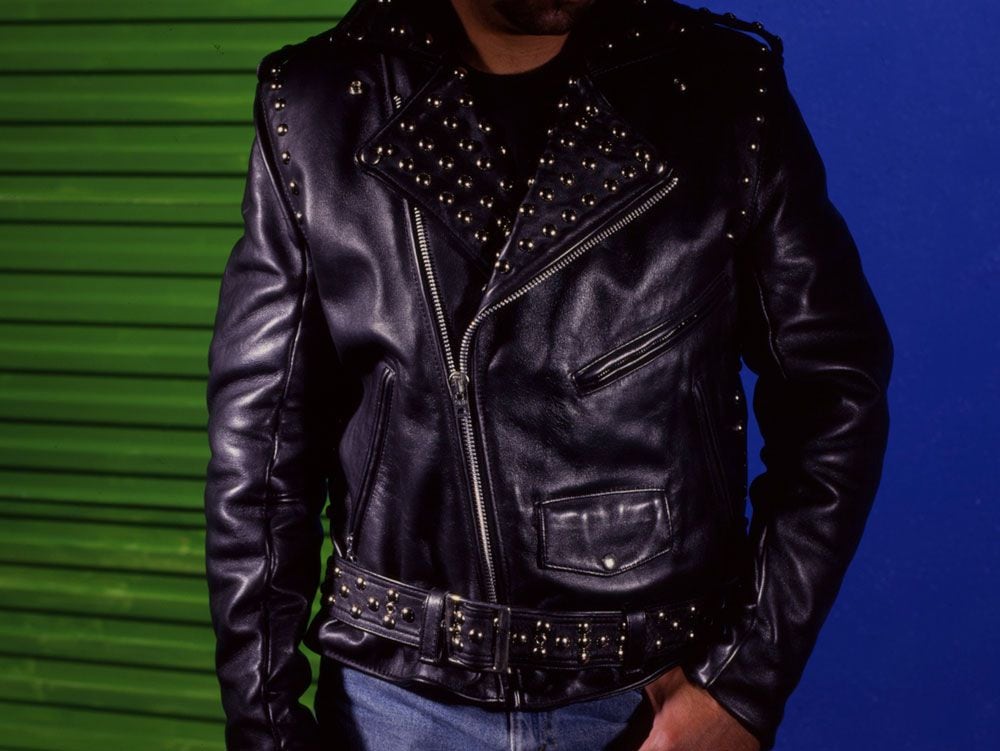The Schott factory in Union, New Jersey, smells like leather, brass, and a hint of tobacco, an aroma familiar to anybody who’s ever pulled on a vintage motorcycle jacket. Inside the workshop, riveters pump away behind antique machinery; seamstresses glide along cotton liners; tailors and tanners pore over drafting tables, cutting patterns, book-matching hide grains. This is how the Schott family made the original Perfecto, the world’s first motorcycle jacket, in 1928. It’s how they still make it today.
Like all great functional designs, the Perfecto was born of necessity. Prewar American outerwear was woefully unspecialized; the materials, usually wool or moleskin, were a nightmare for motorcyclists. Leather waistcoats fared better, but contemporary fits didn’t work in the riding position. Crucially, both used regular buttons on the bib and pockets, which, as the era’s gutsier riders found out, inevitably blew open at high speed. Something needed to change.
Enter: Irving Schott.
The son of Jewish-Russian immigrants, Schott made raincoats in the basement of a tenement building on New York’s Lower East Side. Both a patternmaker and keen motorcyclist, he understood the riding apparel conundrum. Inklings of a solution appeared in 1925, when Irving and his brother, Jack, became the first clothiers to put zippers on a commercial coat. Three years later, Schott Bros. introduced the Perfecto.
The jacket, named for Irving’s favorite cigar cut, screamed utility. It was trim and snug, as to avoid bunching when leaned over a fuel tank. It was hewn from heavy-duty steer or horsehide, ideal for protection and durability. Sleeve length was carefully considered. The pièce de résistance, an asymmetrical zipper, slid diagonally across the chest to allow variable ventilation, double-breasted for additional wind buffering. Next to the era’s formal overcoats, the Perfecto seemed bizarre. But enthusiasts knew what they were looking at, and the rest of the world caught on soon enough. Slouched over a scarlet Triumph in The Wild One, Marlon Brando catapulted young motorcyclists into the zeitgeist. Wearing a custom black Schott Perfecto, he also gave them a uniform.
“It’s more about looks now, but we do still get bikers in here,” says Kat Perez, an associate at Schott’s flagship store in Manhattan. “Since we make everything by hand, customization and alteration isn’t a problem. Buy a size up, and we’ll fit pockets for armor and a back protector.”
But Schott isn’t competing with modern high-performance gear, just as the Empire State Building doesn’t compete with taller skyscrapers. The Perfecto is singular, transcendent. It’s the Platonic ideal of a leather jacket, immortalized in Andy Warhol prints and Ramones album covers, history books and fashion magazines, coveted and cosseted by misfits everywhere. Still, after 90 years, the design remains synonymous with motorcycling because of what it represents: the bolder, braver, better version of yourself.










/cloudfront-us-east-1.images.arcpublishing.com/octane/S2HIXHK6LFPL6VNDPUJ5MVJLLM.jpg)

/cloudfront-us-east-1.images.arcpublishing.com/octane/S35YGSEMEZB4BLTDJTSZPF4GLA.jpg)
/cloudfront-us-east-1.images.arcpublishing.com/octane/5UOT6HPX2JFMRJAX6EH45AR4MQ.jpg)
/cloudfront-us-east-1.images.arcpublishing.com/octane/OKWOJWAKP5EP3OACCRRWPCIX2Q.jpg)
/cloudfront-us-east-1.images.arcpublishing.com/octane/2WF3SCE3NFBQXLDNJM7KMXA45E.jpg)
/cloudfront-us-east-1.images.arcpublishing.com/octane/G4MG6OUCJNBSHIS2MVVOTPX65E.jpg)
/cloudfront-us-east-1.images.arcpublishing.com/octane/IIGGWFOTOJGB7DB6DGBXCCMTDY.jpg)
/cloudfront-us-east-1.images.arcpublishing.com/octane/QSTCM6AVEZA5JJBUXNIQ3DSOF4.jpg)
/cloudfront-us-east-1.images.arcpublishing.com/octane/U4I7G625B5DMLF2DVIJDFZVV6M.jpg)
/cloudfront-us-east-1.images.arcpublishing.com/octane/B6XD6LS6IVCQPIU6HXDJSM3FHY.jpg)
/cloudfront-us-east-1.images.arcpublishing.com/octane/ICL63FEDDRDTTMINYICCEYGMDA.jpg)
/cloudfront-us-east-1.images.arcpublishing.com/octane/FCGZHQXRBZFLBAPC5SDIQLVF4I.jpg)
/cloudfront-us-east-1.images.arcpublishing.com/octane/WNOB6LDOIFFHJKPSVIWDYUGOPM.jpg)

/cloudfront-us-east-1.images.arcpublishing.com/octane/X33NU3E525ECRHXLNUJN2FTRKI.jpg)
/cloudfront-us-east-1.images.arcpublishing.com/octane/6KKT5NNL2JAVBOXMZYS5ZO76YA.jpg)
/cloudfront-us-east-1.images.arcpublishing.com/octane/J5RKG5O455GMPGQRF2OG6LRT7A.jpg)
/cloudfront-us-east-1.images.arcpublishing.com/octane/GX2CIZKQVRH2TATDM26KFG2DAE.jpg)
/cloudfront-us-east-1.images.arcpublishing.com/octane/ZWIDYSAKQZHD5BHREMQILXJCGM.jpg)
/cloudfront-us-east-1.images.arcpublishing.com/octane/CYUHJZCTSJCH3MRAQEIKXK7SCQ.jpg)
/cloudfront-us-east-1.images.arcpublishing.com/octane/LKOFINY56FCXJCANJ5M7ZDQUBY.jpg)
/cloudfront-us-east-1.images.arcpublishing.com/octane/4NBPDACMWJH63JQYJVK3QRBDZI.jpg)
/cloudfront-us-east-1.images.arcpublishing.com/octane/KKHQHRR3FJGX7H2IPU6RALMWG4.jpg)

/cloudfront-us-east-1.images.arcpublishing.com/octane/5IOFS5JAE5FOXMNA23ZRAVVYUU.jpg)